|
|
Audi A7
|
 |
|
|
Debut: 2010
Maker: Audi
Predecessor:
No
|
|
|
|
| Published
on 21
Oct 2010 |
All rights reserved.
|
|
|
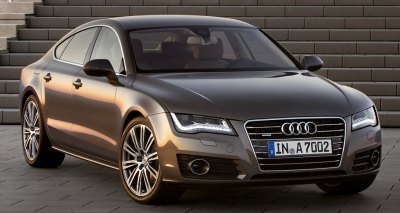
|
Audi joins Mercedes CLS in the club of
four-door coupes...
|
In
the highly competitive
motor industry, economy of scale is very important. When you develop a
new platform, the first thing you would think of is how many cars can
be built upon it every year. Decades ago General Motors used
"badge-engineering" to increase the number of cars based on each
platform. Today, customers are wiser and you have to provide something
really different. Car makers start exploring different kinds of
derivatives never tried before. One of these is "four-door coupe". In
2004, Mercedes-Benz introduced the first modern-time four-door coupe,
CLS. It was derived from the E-class platform to share much of its
development and component costs. Moreover, being a stylish coupe it
could command higher prices than the equivalent sedan. CLS was a
successful attempt, with 170,000 copies sold before its replacement
this year. Its concept caught the attention of Volkswagen group. 4
years later, Volkswagen introduced Passat CC. Two more years later
(now), Audi joins the battlefield with A7. It targets squarely at the
Mercedes.
 |
Size between A6 and A8. Underneath is
the next generation A6 platform.
|
As its name suggested, A7 is
positioned between A6 and A8 in size and market positioning. However,
underneath its clothes is the same underpinnings as the next generation
A6. This mean it has a conventional steel monocoque chassis instead of
the aluminum spaceframe of A8. The advantage is lower production cost,
of course, but on the downside it is heavier than it ought to be. For
instance, an A7 3.0TFSI tips the scale at 1785 kilograms, some 125 kg
more than the new generation CLS350. It could have been heavier still
had it not employed aluminum bonnet, hatch, doors and front bulkhead.
Part of the weight comes from its large size – it measures nearly 5
meters long and runs a 2914 mm wheelbase – that's the size of the last
generation Mercedes S-class ! The rest of the weight attributes to the
high build quality, solidity and refinement Audi built into the car.
You will never disappoint with its quality. It looks extremely well
assembled and painted, and its interior borrows a lot from the A8, no
matter materials, design or the advanced infotainment system. The only
noticeable shortfall is the reduced headroom for rear passengers, yet
for a four-door coupe it is perfectly acceptable. Only those taller
than 6 foot will find headroom a real problem.
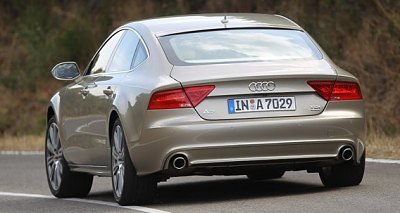 |
Sportback has an electric hatch which
opens to a generous boot
|
The A7 is formally called A7 Sportback because it has a
hatchback door. This door is powered electrically to save your effort.
It opens to a generous boot measuring 535 liters. Fold the rear seats
and it is expanded to 1390 liters, so this car is highly practical.
Encounter it on the road, I suppose many people may confuse it with A5
Sportback. Nevertheless, there are some significant differences between
the two Sportbacks. The A7 does not have a flowing (sexy) waistline
like its smaller sister, but it is compensated with a faster angle
hatchback, a cut-off tail and more stylish lights (head and tail), all
these make it more handsome. Compare to the last generation CLS,
however, its styling is more about subtle elegance than visual impact.
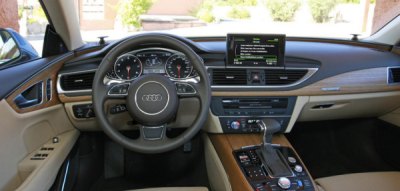
|
Interior resembles A8, just more
driver-oriented.
|
The new A6 platform again offers the
choice of front-wheel-drive or Quattro 4-wheel-drive, the latter is
mandatory for more powerful engines. Advancement from the old car
include the new ML architecture (with clutch moved behind the front
axle to improve weight distribution), 40:60 split Quattro system,
(optional) torque-vectoring active rear differential and A8's adaptive
air suspensions and adaptive dampers. They should cure the moderate
understeer and firm ride of the old A6. Besides, it also gets Audi
Drive Select control system, which offers 3 modes to alter the setting
of suspension, throttle, gearshift, stability control and active
differential. All in all, A7 should be much better to drive than the
last generation Audis.
In the powertrain side, it offers 7-speed S-Tronic gearbox and 3
engines for selection – 2.8-liter FSI Valvelift V6 (204hp), 3.0TDI
diesel V6 (204hp for FWD or 245hp for Quattro) and 3.0TFSI supercharged
V6 (299hp). Those asking for more power will have to wait until the end
of next year, when a newly developed twin-turbo 4.0TFSI V8 is
introduced to S7. By the way, that engine will also serve Bentley.
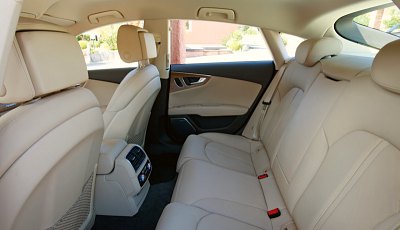
|
Rear headroom is tight only to those
over 6 foot tall...
|
Forget the mirage. The highest
performance model now is 3.0TFSI. Although to haul the big car its
performance is not especially sparkling (0-60 mph taking 5.3 seconds is
rather normal these days), it is stronger and more flexible than
Mercedes CLS350, thanks to its supercharger. Refinement is generally
good, except at high rev there is some harshness coming from the
supercharger. Its flawless cooperation with the twin-clutch gearbox is
especially satisfying, delivering smooth acceleration and excellent
cruising refinement on highway.
Thanks to the rigid chassis and adaptive air suspensions, the A7 rides
firmly without harshly. In fact, its decent ride could be a surprise to
those familiar with Audi. Less surprising is handling. You won't pick
any problems from the way it controls its pitch and roll or suppresses
its inherent understeer. It does these quite well. Moreover, the
Quattro system continues to provide extra traction and wet-road
security its rivals could not match. Nevertheless, the A7 is still
short of driver involvement. Its electrical power steering is too light
and devoid of feedback. Switching on Sport mode will only weigh up,
firm up or quicken everything without adding feel. Its Mercedes rival
delivers a better drive.
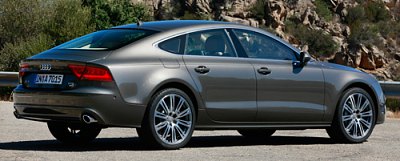 |
Conservative is the philosophy behind
the beautiful body
|
Overall speaking, the A7 is an
admirable effort from Audi. It looks stylish. It is practical, refined
and impeccably built. Its performance is just right. Its chassis
dynamics is reassuring. Not very fun to drive, but that should not be a
big problem to the majority of customers. In my opinion, its biggest
problem is its failure to stand out from the crowd. It copies the
concept of Mercedes CLS without improving it. Even among the Audi
family, it does not appear to be special enough. Its architecture,
technologies, pros and cons are all so familiar to us. Not even its
appearance is as striking as it should be. Isn't Audi too conservative
these days ? |
Verdict:     |
| Published
on 29
Apr 2012 |
All rights reserved.
|
|
Audi S7
|

Many
motoring journalists love the new S7. They praised the car for
beautiful design, impeccable build quality, good performance, good
refinement and the inclusive of many high-tech features. They said you
can hardly find a better alternative for day-to-day high-speed
motoring. Aren't those descriptions familiar? Yes, we heard the same
for the lesser A7 3.0TFSI and 3.0TDI. So what makes the S7 superior to
them and worth the "S" badge? A sporting character, I suppose.
Unfortunately, that is also what the car so wanting.
On paper, the S7 does look sporty. Despite of a deliberate detune, its
new 4.0TFSI V8 (same as sister car S6)
still produces a respectable 420 horsepower. Even more impressive is
that 406 pound-foot of twisting force is available from merely 1450 rpm
all the way to 5250 rpm. In addition to 7-speed S-Tronic gearbox and
Quattro system, you get a seamless acceleration off the line, cracking
60 mph mark in 4.7 seconds. Not only quick in straight line, the S7
should be capable in bends too, thanks to a variable ratio steering, a
crown-gear center differential with 40:60 torque split,
torque-vectoring rear differential and an adaptive air suspension that
is set 10 mm lower than other A7s. In other words, the S7 packs the
same mechanicals as S6.
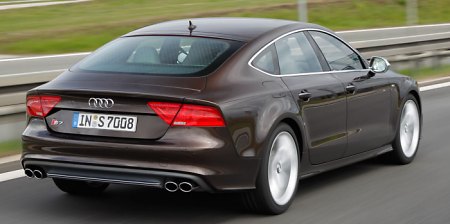
In the real world, the S7 is undeniably quick, but its sense of speed
matches Mercedes CLS500 rather than the full-blooded AMG model or M5.
Fans of Audi may immediately point out that the S7 actually aims at the
same audiences of CLS500 and forthcoming 650i Gran Coupe, as its
£62,000 price tag shows. However, when a similarly priced Jaguar
XFR offers superior performance and an aural excitement that the S7 so
lacking, we wonder the need to go to the Audi camp. Moreover, the
Jaguar is also far more fun to drive. In comparison, the S7 feels
uncomfortably big and heavy on B-roads. It rolls too much, it steers
with little enthusiasm and its S-Tronic gearbox sometimes feels clunky
at low speed. The countless of electronic gadgets fail to hide its 1945
kg mass. A sportier suspension setup might solve the problem, but it
could damage ride comfort further, which is already quite firm now. The
self-regulated V8 also leaves something to be desired. It does not
encourage you to go beyond 6000 rpm. Even if you do, the gearbox will
upshift mandatorily at 6200 rpm. So fast and efficient aside, the S7's
performance has little to cheer about.
Compare with the mechanically identical S6, the S7 is marginally slower
and duller in chassis response because it carries an extra 50 kg. The
S6 is also £8,000 cheaper. In return, the S7 gives you a classier
style and the convenience of hatchback. However, neither cars can
satisfy the desire of keen drivers. |
Verdict:    |
| Published
on 21
Jul
2013 |
All rights reserved.
|
|
Audi RS7
|
|
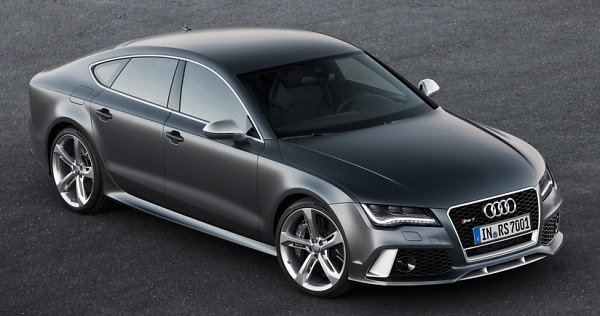
|
I am not so keen on Audi S7
because it doesn't look special enough and doesn't connect to the
driver. Then how about the range-topping RS7 that is prepared by
Quattro GmbH – Audi's performance department? Judging on looks alone,
it is definitely better than the S7. Although its body shape is still
too civilized, some styling tweaks inject extra sense of thrills, such
as the mesh grilles, alloy blades around the nose as well as the
eye-catching 21-inch wheels, although the latter do come at the price
of ride quality. It doesn't look so good at the back, which is probably
too tamed and even family cars-like. All in all, its exterior design is
passable for a performance car.
As expected, the RS7 is virtually an RS6 in a sportier shape. Both cars
share the same 4.0 TFSI twin-turbo V8 with cylinder deactivation
technology. It produces 560 horsepower and 516 pound-foot of torque.
The latter is a jump of 110 lbft from the S7 (which uses the detuned
version of the same engine) so that it has to abandon the S-Tronic
twin-clutch gearbox for the more robust 8-speed automatic from ZF.
Never mind, this torque-converter auto has been renowned for seamless
and responsive gearshifts and impeccable mapping. It suits the engine
well and produces performance rivaling some second-tier supercars. Top
speed is normally governed at the usual 155 mph, but you can pay extra
to raise the limit to 174 mph (280 km/h) or even 190 mph (305 km/h),
which is the same as RS6. Acceleration is also identical to the latter,
with 0-60 mph quoted at merely 3.8 seconds. You might expect the 4-door
coupe to be quicker than its 5-door Avant sister, but bear in mind that
it is only 15 kg lighter, the identical performance figures are
reasonable.
Still, 0-60 under 4 seconds is amazing for a luxury car weighing nearly
2 tons. It will beat BMW M6 Gran Coupe, if not the 4matic version of
Mercedes CLS63 AMG and the 4-wheel-drive Porsche Panamera Turbo. If
there is any difference between these cars, it would not be absolute
speed but how you feel the speed through your ears. The 4.0 TFSI engine
is too civilized. Its sportiness is only briefly revealed by the pops
and crackles on overrun, while the rest of the time it remains as quiet
as a luxury car engine. Even when you wind it to the top end, its noise
is dominated by turbo whoosh, which is rather uninspiring compared with
the throaty V8 exhaust note on AMG. Therefore it is hard to engage your
soul.
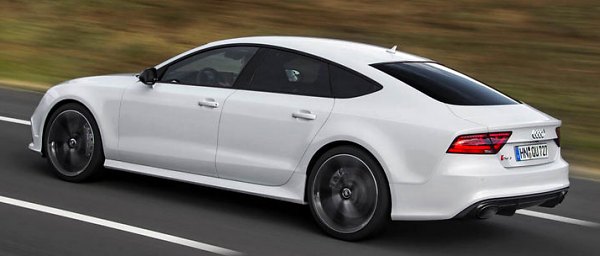
|
Apart from powertrain, the running gears and suspensions are
also shared with RS6. It gets the slightly rear-biased (40:60) Quattro
system with crown-gear center differential, the responsive
variable-ratio steering and the electronic active rear differential.
The latter is an effective tool to tame its inherent understeer. Unlike
the RS6 though, DRC suspension (which links diagonal shock absorbers
hydraulically, offering not only adjustable damping but also better
pitch and roll control) is not compulsory. You can opt for the S7's
adaptive air suspension at no extra cost if you cannot put up with the
rock-hard ride of DRC. For reasons unknown, the DRC-equipped RS7 rides
poorer than the RS6, so hard that it is only suitable to the smoothest
highway. With air suspension instead, it rides okay when the Audi
Select Drive control system is set to Comfort mode, but in Dynamic mode
it is still too hard compared with its AMG, BMW and Porsche rivals.
Apparently, the nose-heavy Audi needs harder suspension to contain its
extra body motion.
In Audi's fashion, the RS7 offers strong grip and traction thus allows
you to drive remarkably quick on open roads. Nevertheless, it once
again fails to involve the driver. Its steering is lifeless, not only
because it feels numb but also it lacks self-centering. In Comfort mode
you can even feel the wheel tugs in you hands, which reads Torque
Steer. In Dynamic mode the steering is too quick to the extent that it
feels unnatural. In fact, the whole driving experience feels
artificial. The steering, the Quattro and the electronic differential
work busily to trim its understeer, to keep its front tires on track
and quicken the turn-in, but unfortunately, these interventions can be
felt and they are no replacement to inherent balance. On CLS63 AMG (or
to lesser extent M6 Gran Coupe), you can alter the balance on throttle.
You can trust the information given by the steering wheel to determine
the right angle and throttle. This is simply impossible on the
complicated RS7. The RS7 is unquestionably a fast car, but as we always
say, fast is not equal to fun. Lacking visual, aural and driving
thrills, it is hard to recommend.
|
Verdict:    |
|
|
|
|
|
|
|
|
|
|
A7 3.0TDI
|
2010
|
| Front-engined,
4WD |
| Steel monocoque |
Steel + aluminum
|
4969 / 1911 / 1420 mm
|
| 2914 mm |
V6, 90-degree, diesel
|
| 2967 cc |
DOHC 24 valves
|
VTG turbo
|
| CDI |
| 245 hp |
| 369 lbft |
7-speed twin-clutch
|
F: 5-link
R: multi-link
|
-
|
| 255/45ZR18 |
1785 kg
|
| 155 mph (limited) |
6.2 (c) / 6.7*
|
| 18.7* |
|
A7 3.0TFSI
|
2010
|
| Front-engined,
4WD |
| Steel monocoque |
Steel + aluminum
|
4969 / 1911 / 1420 mm
|
| 2914 mm |
V6, 90-degree
|
| 2995 cc |
DOHC 24 valves, VVT
|
Supercharger
|
| DI |
299 hp
|
| 324 lbft |
7-speed twin-clutch
|
F: 5-link
R: multi-link
|
-
|
| 255/45ZR18 |
1785 kg
|
| 155 mph (limited) |
5.3 (c)
|
| - |
|
A7 3.0TFSI (US)
|
2010
|
| Front-engined,
4WD |
| Steel monocoque |
Steel + aluminum
|
4969 / 1911 / 1420 mm
|
| 2914 mm |
V6, 90-degree
|
| 2995 cc |
DOHC 24 valves, VVT
|
Supercharger
|
| DI |
310 hp
|
| 324 lbft |
8-speed automatic
|
F: 5-link
R: multi-link
|
-
|
| 255/45ZR18 |
1785 kg
|
| 155 mph (limited) |
5.1** / 4.7***
|
| 12.8** / 11.9*** |
|
|
|
|
|
Performance
tested by: *Autocar, **C&D, ***R&T
|
|
|
|
|
|
|
S7
|
2012
(2014)
|
| Front-engined,
4WD |
| Steel monocoque |
Steel + aluminum
|
4980 / 1911 / 1408 mm
|
| 2916 mm |
V8, 90-degree
|
| 3993 cc |
DOHC 32 valves, DVVT
|
Twin-turbo
|
DI, cylinder deactivation
|
420 hp / 5500-6400 rpm
(450 hp / 5800-6400 rpm)
|
406 lbft / 1450-5250 rpm
(406 lbft / 1400-5700 rpm)
|
7-speed twin-clutch
|
F: 5-link
R: multi-link
|
Adaptive air spring + damping
|
| 255/40ZR19 |
1945 kg (1955 kg)
|
| 155 mph (limited) |
4.7 (c) / 3.9* / 4.0**
(4.4 (c) / 3.9***)
|
9.8* / 9.7**
(9.7***)
|
|
RS7
|
2013
|
| Front-engined,
4WD |
| Steel monocoque |
Steel + aluminum
|
5012 / 1911 / 1419 mm
|
| 2916 mm |
V8, 90-degree
|
| 3993 cc |
DOHC 32 valves, DVVT
|
Twin-turbo
|
DI, cylinder deactivation
|
560 hp / 5700-6600 rpm
|
516 lbft / 1750-5500 rpm
|
8-speed automatic
|
F: 5-link
R: multi-link
|
Adaptive damping
|
| 275/35ZR20 |
1920 kg
|
| 190 mph (limited) |
3.8 (c) / 3.2* / 3.2** / 3.4*** /
3.5****
|
8.0* / 7.9** / 7.8*** / 8.0****
|
|
RS7 Performance
|
2016
|
| Front-engined,
4WD |
| Steel monocoque |
Steel + aluminum
|
5012 / 1911 / 1419 mm
|
| 2916 mm |
V8, 90-degree
|
| 3993 cc |
DOHC 32 valves, DVVT
|
Twin-turbo
|
DI, cylinder deactivation
|
605 hp / 6100-6800 rpm
|
553 lbft / 2500-5500 rpm
|
8-speed automatic
|
F: 5-link
R: multi-link
|
Adaptive damping
|
| 285/30ZR21 |
1930 kg
|
| 190 mph (limited) |
3.6 (c) / 3.2*** / 3.4*****
|
7.3*** / 7.5*****
|
|
|
|
|
|
Performance
tested by: *MT, **R&T, ***C&D, ****Auto Bild, *****Autocar
|
|
|
|
|
|
|
|
|
Copyright©
1997-2016
by Mark Wan @ AutoZine
|
|